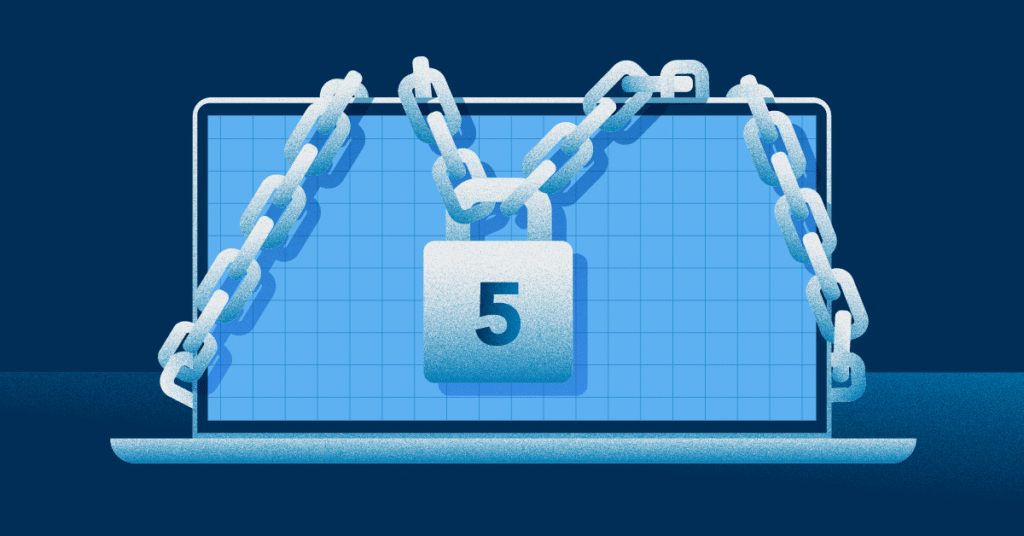As technology continues to evolve, it’s more important than ever for companies of all sizes to implement the best available practices and protocols to protect sensitive data. This includes data pertaining to your customers’ personal information and your business operations.
An effective data privacy program and a robust data privacy platform can protect company assets and assure customers that their personal information is being handled correctly. However, you must also ensure that your data privacy reports and protection strategies comply with laws and regulations to avoid steep non-compliance fines and ensure your data is not at risk.
In this guide, we’ll explore how to improve data privacy by diving into data protection basics, data risks, and five ways to bolster your data protection.
What Is Data Privacy?
So, what is data privacy exactly? It is the combination of laws, regulations, practices, and procedures that govern how private, personal information is handled. Primarily, data privacy is concerned with protecting the rights of individuals and regulating how their personal information is shared and used.
For example, data privacy laws may regulate which third-party enterprises have access to the information. While media agencies, suppliers, and network security tools may be granted access, other more malicious third-party vendors will be blocked.
To that end, all companies must responsibly handle sensitive data. This includes healthcare facilities that must file medical records and beauty salons that have access to client’s credit cards and contact information.
What Information Is Considered Private?
Knowing how to improve data privacy begins with knowing what data is considered private in the first place.
In general, private data is any information that an individual shares with a company or another individual that they might reasonably expect to be kept private. In our increasingly digitized society, this means that private data includes the most traditional forms of identifying information as well as information about how individuals behave online.
More specifically, private data is generally understood to include:
- Personal information – This includes identifying information like name, age, and date of birth.
- Contact information – Phone numbers, physical addresses, mailing addresses, usernames, and other ways of contacting a person are all considered private data.
- Medical information – Data relating to an individual’s medical or health history is among the most protected forms of private data, regulated by such frameworks as the Health Insurance Portability and Accountability Act (HIPAA).
- Financial information – From account numbers and credit card records to investment documents, data privacy aims to protect the financial data of consumers.
- Online information – The data associated with how a person behaves online is a crucial element of data privacy. Browsing history, shopping behaviors, and search terms are a few examples of data that are considered private.
Risks to Data Privacy
There are many threats to proper data management, from human error to hacker interference. Fortunately, knowing the most common risks to your data privacy helps to automate your privacy program and mitigate online theft.
As such, here are common forces that may threaten your company’s data privacy:
- Outside attacks – Cyber criminals like illegal hackers and data miners often aim to steal your company’s most sensitive information. They infiltrate your systems through ransomware attacks, malware scams, phishing expeditions, and other cyberattacks. In addition, cyberattacks may also leave your sensitive data damaged, incomplete, or inaccessible. It may even lead to complete data loss.
- Inside threats – On the other hand, cyber threats to data privacy don’t always come from outside your company. In fact, almost 57% of data breach incidents originate with employees who steal personal data and sell it to third parties. Additionally, employees who have access to private data are uniquely susceptible to security threats and bribes, putting the data at further risk.
- Insufficient data security – Unfortunately, not all businesses are doing their part to ensure data security. From using unsecured devices and passwords that don’t pass muster to lackluster security programs, the failure to implement strategic data security measures is a significant risk for businesses.
- Accidental mishandling – Often, data privacy breaches are the result of error more than negligence or wrongdoing. There’s always a risk that employees may accidentally share, distribute, or otherwise mishandle private data. As such, proper training and clear, actionable protocols are ways companies can prevent accidental mishandling of data.
- Lenient access protocols – Inefficient data gatekeeping is another big risk to data privacy. Individual data should be accessible only to those in your company who need it. The more access points you have for your data and the more people who are accessing it, the greater your chances of exposing that data to attacks, security breach, and other forms of mishandling.
- Complicated laws and regulations – Data privacy includes the various laws, regulations, and policies that state and federal governments enact to protect the rights of individuals. Unfortunately, new regulatory guidelines, like the European Union’s General Data Protection Regulation (GDPR) in 2018 and the California Consumer Privacy Act, are cropping up every day. And more protocols are expected over the next few years. Without keeping up with and understanding these regulations, businesses can be fined for non-compliance.
Common Data Privacy Issues
Each of these risks can make establishing an effective data privacy policy difficult. In addition to insufficient operating procedures, human error, and noncompliance, common data privacy issues also include:
- Data growth – Data is exponentially growing, making it more difficult to protect large quantities of personal information against cyber attacks and breaches.
- Advancing technologies – As hacker mechanics become more advanced, your company’s data becomes increasingly more susceptible to data breaches. More specifically, it was reported that IoT cyberattacks escalated in 2021 with some 1.51 billion breaches. As such, it was found that vulnerabilities have increased due to prolonged use of personal devices for both personal and enterprise use.
- Costs – To ensure that your data is properly protected, your company must invest in archiving, backup, and monitoring systems to prevent breaches. Additionally, if your company does experience a data breach, it could mean losing millions of dollars in revenue and paying regulatory penalties.
5 Ways to Improve Data Privacy
With so many factors undermining data privacy, protecting your company’s data is becoming increasingly more difficult. However, there are several steps you can take to bolster your data privacy and scale your privacy programs.
#1 Back Up Everything
Ensuring that every piece of your company’s data is backed up is a crucial and simple step you can take to improve your data privacy.
Cyberattacks can crash your business network and erase highly important data, sometimes permanently. Even if you can retrieve your data, your business may still suffer. A staggering 93% of businesses that lose their data for more than 10 days following a cyberattack end up filing for bankruptcy within a year.
This is because data loss due to cyberattacks affects every part of your business, beyond your data privacy infrastructure and the information it contains. The inability to access your company’s vital data can lead to:
- Lowered productivity
- Damaged consumer trust
- Fines, lawsuits, and other legal action
To mitigate disruption to your operations, it’s recommended that companies keep at least three backup copies of their data. Additionally, one of these copies should be stored in a cloud system or another off-site location.
#2 Secure or Restrict Personal Devices
From accessing company emails on personal cell phones to working from home on the family computer, the devices that you and your employees use represent a minefield of data privacy threats. But taking steps to secure those devices and limiting the number of personal devices accessing data can help strengthen your data privacy efforts.
To combat the risks posed by device use, you should focus on:
- Securing devices – No one should be accessing your company’s data from an unsecured device. That means only using devices with adequate encryption software and other important security measures.
- Limiting devices – Limiting data access to devices that are only issued by your company can help to safeguard data.
#3 Restrict Personal Email Use
Your employees use their personal email addresses for a wide range of purposes, from online shopping to managing their streaming subscriptions. However, personal emails should never be used to conduct company business.
Instead, make sure that all of your employees have and use a verified company email. This allows you to implement a number of important precautions, such as:
- Data encryption
- Attachment restrictions
- Company security settings
#4 Create Strong Passwords
Every day, cybercriminals get more and more adept at unscrambling passwords that allow them to access private networks. That means that the passwords that you and your employee use need to be strong enough to mitigate hacker interference.
Increase the strength of your passwords by:
- Using complex passwords with a variety of symbols, numbers, and cases
- Changing passwords every 6 months
- Storing passwords in safe, secure places
#5 Test Your System
Unless you test it, there’s no way to know how well any given data privacy strategy works. Testing your security systems and protocols and making necessary adjustments means you’ll be better prepared—and better protected—in the event of data leaks, breaches, or attacks.
Testing your security can be as simple as:
- Performing an audit – Hiring a reputable organization to assess the viability of your data privacy is an excellent way to gain crucial insights into how well your security is performing. It can illuminate issues you might have missed and key you into other tips on how to improve data privacy.
- Testing your employees – Performing routine security tests on your employees, like sending them fake phishing emails, can help identify weaknesses among your staff. This allows you to provide extra data privacy training and education as well.
DataGrail: Better Privacy for Better Businesses
To keep your business operations running smoothly and maintain customer trust, you must identify vulnerabilities within your systems and make the proper adjustments to ensure that your data is secure.
If you’re looking for backup, consider partnering with a data privacy platform like DataGrail.
From streamlining your data privacy strategy to untangling complicated regulatory guidelines, we give businesses owners a simple, easy-to-use platform to automate, scale, and regulate their data privacy programs.
Request a demo and take control of your data with DataGrail.
Sources:
Simplicable. 9 Examples of Private Data. https://simplicable.com/new/private-data
Verizon. 2019 Insider Threat Report. https://www.verizon.com/business/resources/reports/insider-threat-report/
Storage Networking Industry Association. What is Data Privacy? https://www.snia.org/education/what-is-data-privacy
Tech Republic. Data Privacy Laws Are Constantly Changing: Make Sure Your Business is Up To Date. https://www.techrepublic.com/article/data-privacy-laws-are-constantly-changing-make-sure-your-business-is-up-to-date/
Forbes. Eight Simple but Effective Ways to Improve Your Company’s Data Security. https://www.forbes.com/sites/theyec/2021/10/20/eight-simple-but-effective-ways-to-improve-your-companys-data-security/?sh=73e286b57e7f
IoT World Today. IoT Cyberattacks Escalate in 2021, According to Kaspersky. https://www.iotworldtoday.com/2021/09/17/iot-cyberattacks-escalate-in-2021-according-to-kaspersky/

